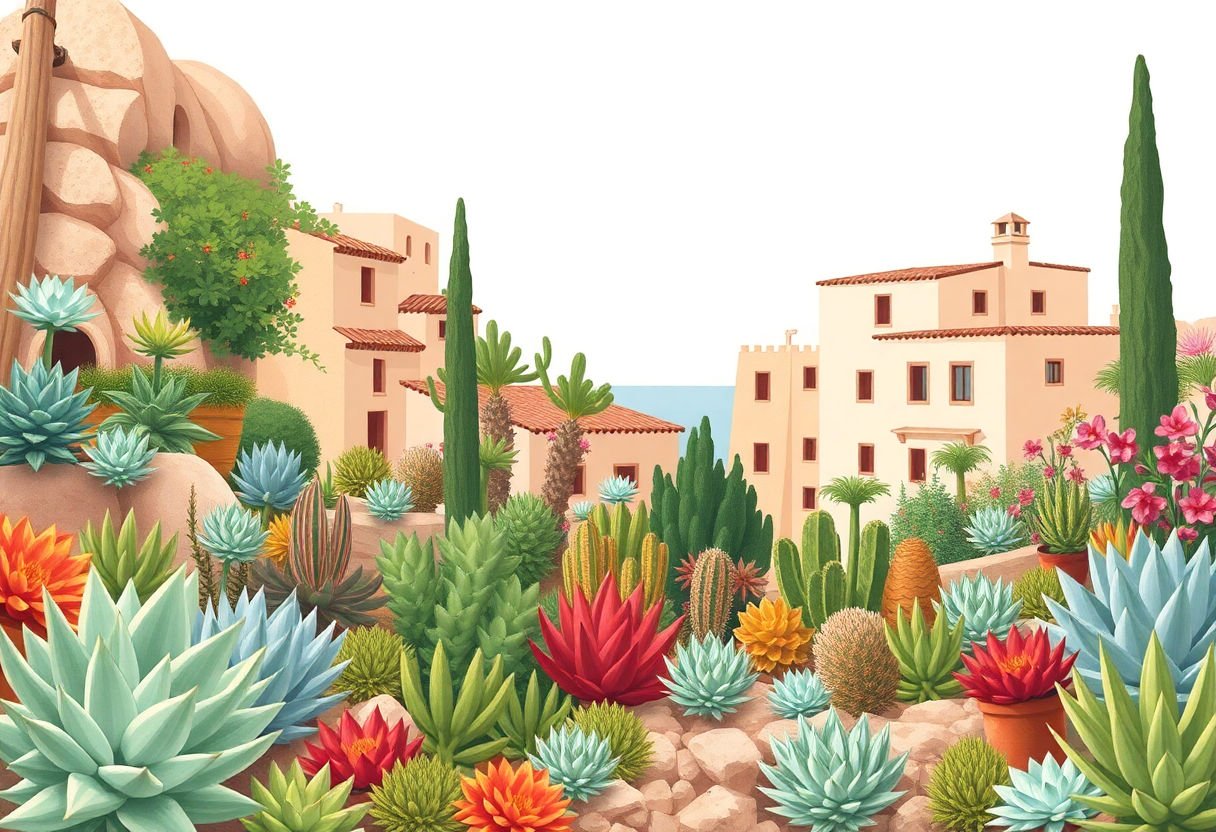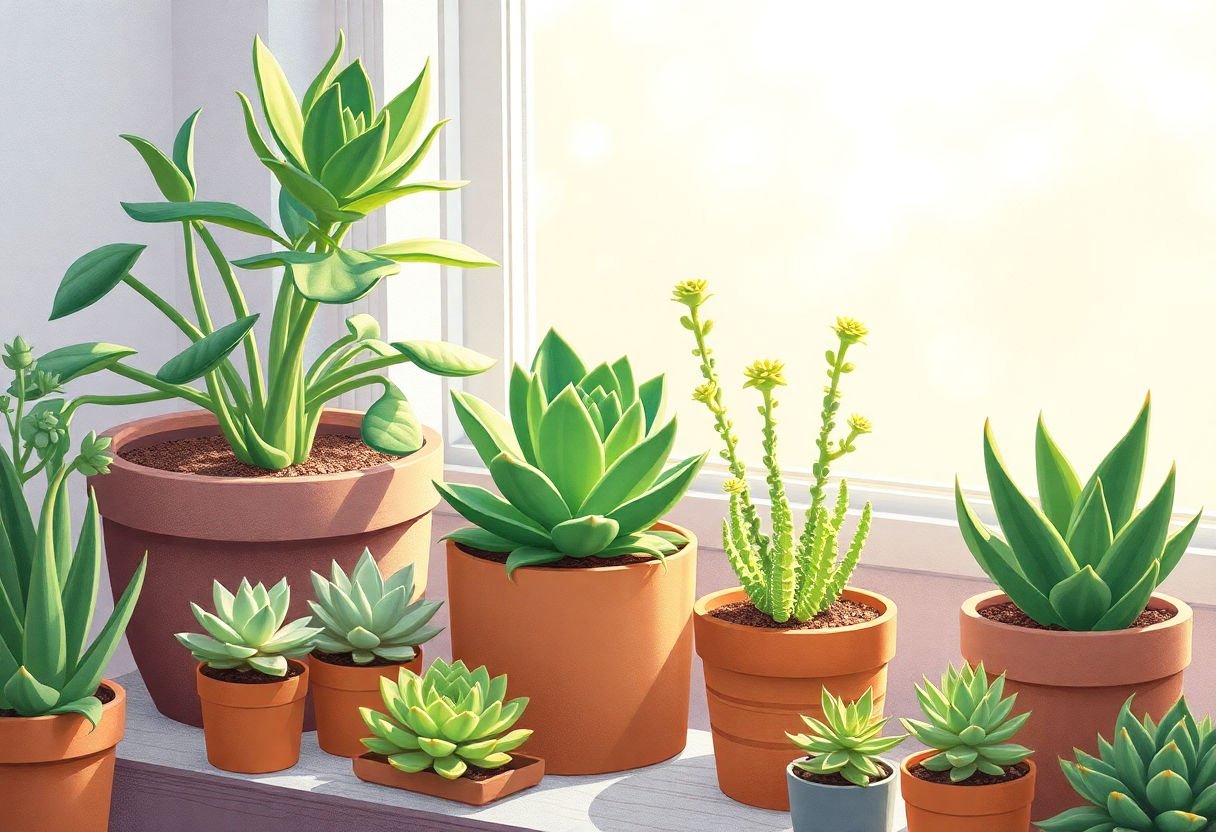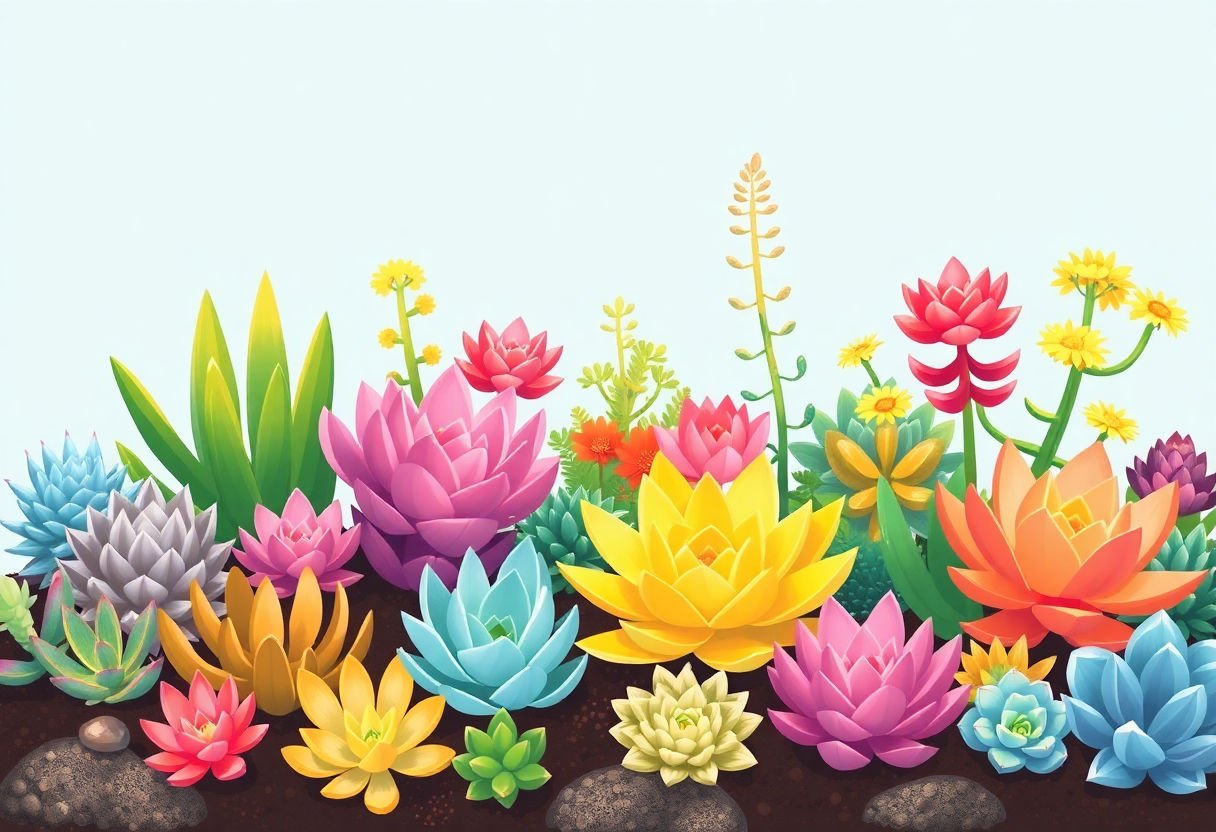Succulents are special plants that many people love. They need little water and thrive in the right places. Choosing the best climate zones helps these plants stay healthy and beautiful. We will talk about why climate matters so much for them, from dry deserts to warm Mediterranean regions. You will also find out how they can grow in cooler areas with some care. If this topic interests you, keep reading to learn more about the best places for your succulents to shine.
Key Takeaways
- Succulents flourish best in arid and desert climates due to the dry conditions they enjoy.
- Mediterranean climates also offer a great environment for succulents with their warm and dry weather.
- You can grow succulents in coastal and temperate climates by using specific care strategies.
- Microclimates and indoor settings allow control over moisture and light, aiding succulent growth.
Understanding Climate Zones

Climate zones play a big role in how well succulents grow. These zones tell us about the weather in a place. The weather includes changes in temperature, rain, and if there is frost. By knowing about climate zones, we can find the best places for succulents to live.
Why It Matters
Succulents need dry and sunny spots. They store water in their leaves. This makes them good at living in harsh places. But, if it rains too much or is too cold, succulents may not do well. Understanding climate zones helps us pick spots where succulents will thrive.
Key Features of Climate Zones
- Temperature: Warm to hot temperatures help succulents. They don’t like the cold.
- Rainfall: Little rain is best. Too much water can cause rot.
- Sunlight: Bright sunlight is ideal. Shades can stop growth.
Climate Zone Examples
- Desert Zones: Perfect for succulents. Hot in the day, cooler at night. Little rain.
- Mediterranean Zones: Warm summers, mild winters. Dry seasons fit succulents well.
- Coastal Zones: Can work with care. Fog and moisture need managing.
By looking at these zones, pick a place that’s good for succulents. In cooler areas, a greenhouse or sunny windowsill can help. Knowing about climate zones is like having a map for growing happy, healthy plants.
Importance of Climate for Succulents
Succulents love certain climates. They come from places with dry air and little rain. So, they need similar conditions to grow well. Climate matters a lot for them.
The Right Climate: Key to Growth
Think of succulents like camels. Both store water to survive dry weather. Succulents need dry and warm climates. Too much rain can harm them. Wet roots can make them rot.
Heat and Sunlight
They thrive under the sun. It gives them energy and helps the leaves stay firm. Hot days mean more growth. But not too hot. Scorching heat can cause sunburn on leaves. Afternoon shade can help in very hot areas.
Cold Weather Challenges
Cold is tricky for succulents. Some can handle light frost, but most prefer mild winters. If you live where it gets cold, you can keep them indoors. A sunny window works well.
Humidity Levels
Humidity is another factor. Succulents prefer low humidity. High moisture can make them soggy. Airflow helps keep them dry.
Rainfall and Watering
Rainy weather means less watering. But drought-prone areas mean more care. Keep track of the local climate to water them the right way.
In short, choose the best climates to suit your succulents. Whether keeping them outside or indoors, remember their needs. They are hardy yet delicate in their own way. With the right climate, succulents can flourish beautifully.
Arid and Desert Climates
Desert climates often bring to mind endless stretches of sand and an intense sun overhead. These places can get very hot during the day and cold at night. Rainfall is rare, with less than 10 inches a year.
Many succulent plants love this type of weather. They soak up the sun without too much stress. The dry air means they rarely get soggy, making it easier to control the water they store. In arid climates, the soil drains quickly, which is perfect for succulents. They thrive on dry roots and plenty of sunshine.
Consider the cactus. Many call deserts home. Their thick skins help them hold water. This is vital because rain is infrequent.
Aloe plants also thrive in deserts. They can store moisture for a long time. This helps them survive dry spells. Yucca plants, with their sharp leaves, fit right in too.
Succulents do well here. But, they still need a little care. Too much water can cause their roots to rot. Water them just enough to keep them happy.
If the sun is too harsh, some shade can help. A bit of cloth or a nearby bush might provide relief during the hottest part of the day.
Overall, the desert offers a playground for these hardy plants. With sun and sandy soil, they show just how tough and beautiful they can be.
Mediterranean Climate

The Mediterranean climate creates an ideal setting for succulents. This climate, found in places like California and the Mediterranean coast, features warm, dry summers and mild, wet winters. Succulents thrive here because they love warmth and can tolerate dry periods.
Think about a lazy summer afternoon. The sun warms your skin, and gentle breezes cool the air. This is perfect for succulents. They store water in their leaves and stems, so they do not need frequent watering. Instead, they bask in the sun for most of the year. But when the rain comes, these plants soak up the moisture and get ready for the dry times again.
In Mediterranean areas, the soil type also makes a difference. Succulents prefer well-drained, sandy soil. This prevents water from puddling around the roots. Excess water harms succulents, so good drainage keeps them healthy.
The key features of this climate that help succulents include:
- Long, warm summers with little rainfall
- Mild winters with moderate rain
- Sandy, well-drained soils
Although some rare frost can occur in winter, it is harmless to most succulents if brief. For gardeners, it is wise to plant succulents in pots. Move them indoors if a cold snap hits. This simple step can protect your plants and help them flourish.
Why do succulents love the Mediterranean climate? The answer is simple. It offers the perfect mix of sun, warmth, and a bit of rain when needed. These elements create a natural home where succulents can grow vibrant and strong.
Coastal Climates

Coastal climates bring unique conditions for succulents. These gardens often face humid air and salty winds. This environment can surprise succulent owners. Yet, succulents remain versatile. With a few tips, you can succeed.
Consider the salt in the air. Salt can harm succulent leaves. Use barriers, like garden nets or taller plants, to protect your succulents. A simple setup helps a lot. Also, wash the leaves with fresh water occasionally to remove salt.
Humidity is another challenge. Succulents prefer drier conditions. They store water in their leaves, so too much moisture can cause trouble. Good drainage becomes essential. Use pots with holes and well-draining soil. This simple choice can prevent rot.
Morning sun works best in coastal areas. The sun dries any dew and provides warmth without burning the leaves. Place your pots in sunlight during early hours. Rotate them for even growth.
Lastly, choose the right succulents. Some enjoy coastal settings more than others. Consider agave or certain sedums. They adapt well and can make a beautiful garden by the sea.
By understanding these basics, succulents can flourish near the coast. Enjoy their beauty as they grow strong and purposeful.
Adapting to Temperate Climates

Succulents can adjust well to temperate climates. These zones have clear seasons. Summers are warm, but winters can be cold. To help succulents thrive, give extra care in cool months.
Winter Care Tips
- Protection: Use frost cloths or bring plants indoors. Cold air can harm them.
- Watering: Keep watering to a minimum. Too much water makes roots rot.
- Sunlight: Move them to places with bright light. Sun helps them stay healthy.
Soil Choice
In temperate zones, the right soil is key. Use porous soil. It should drain well. Mix sand or perlite to help water flow. This stops water from staying too long around the roots.
Keeping a Watchful Eye
Keep an eye on weather forecasts. A sudden frost or drop in temperature can damage succulents. Stay ready to act. Cover the plants or move them if needed.
Picking the Right Spots
When growing outside, choose smart locations. Sheltered spots near walls or structures provide warmth. Sunlight reflects off walls, keeping the area warm enough, even on colder days. This simple step makes the difference.
With good care, succulents will flourish in temperate climates. Your extra effort brings a little desert magic to these varied zones.
Microclimates and Indoor Growing

Succulents do well in special climate pockets called microclimates. These small areas have their own conditions that differ from surrounding spaces. Even a sunny windowsill in a chilly room can become a warm haven for succulents. One room can have a warmer, sunnier spot than another. You can use these spaces to your advantage.
Creating a good indoor spot for succulents involves managing light, temperature, and humidity. Bright light is the best. A window facing south usually provides this. But watch out for too much direct sun. It can scorch the plants. If you spot any signs of sunburn, move the plant a little further away or add a sheer curtain for protection.
Temperature plays a key role. Succulents prefer it warm. Keep them away from cold drafts or vents. With indoor heating, remember some spots can become too dry. Consider using a small humidifier to maintain the right moisture levels. Or place a shallow tray of water near the plants to add humidity.
In very cold regions, indoor growing offers a chance for succulents to survive winter. You can control their environment without worrying about frosts. But lighting can be a challenge when days get shorter. Grow lights help provide the extra hours of light needed during this time.
Here’s a quick list to make the best indoor growing space for succulents:
- Pick a warm, sunny spot.
- Protect from too much direct sun.
- Watch the temperature; keep away from cold drafts.
- Use a humidifier if necessary.
- Utilize grow lights in winter.
Your care makes all the difference. The right microclimate helps succulents thrive wherever you are.
Conclusion
Choosing the right climate zone can bring new life to your succulents. These plants thrive best in settings that match their natural habitats. Desert and Mediterranean climates offer ideal conditions with warmth and dryness. In cooler areas, succulents need extra care. Indoor spaces and microclimates can mimic the perfect environment. With the right choices, your garden can flourish. Keep experimenting. Every climate has potential. Your succulents will thank you with vibrant growth. Happy gardening!
Frequently Asked Questions
Can succulents thrive in any climate zone?
Succulents thrive best in arid and Mediterranean climates. These areas offer the dry and warm conditions they prefer. In colder or wetter zones, indoor growing or microclimates can help.
How do microclimates affect succulent growth?
Microclimates create conditions that can be warmer or drier. By placing succulents near a sunny window or using a heater, you can mimic their natural habitat, even in less ideal zones.
Why is it important to choose the right climate zone for succulents?
The right climate ensures healthy growth and reduces maintenance needs. When planted in their preferred climate, succulents require less water and are less prone to disease.
Can succulents survive in temperate climates?
Yes, with adjustments. Bring them indoors during cold months or create warm spots in the garden. Proper care can help them survive and even thrive.
What happens if succulents get too much water?
Too much water can lead to root rot. Their roots are designed for dry soil. Ensure proper drainage and let soil dry out between waterings to keep them healthy.
